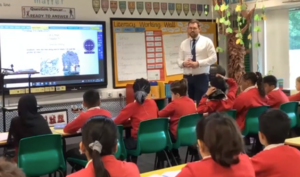09.25.24Seven Details from Matthew Tipton’s use of Everybody Writes

Matthew and his class discussing “The Magician’s Nephew”
I’ve been posting a lot recently (here and here for example) about the power of writing to boost Ratio in the classroom- how writing among other things can cause every student to answer a question instead of just a few who volunteer to speak and how the desirable difficulty writing create facilitates learning and memory.
So I thought I’d share this outstanding example from Matthew Tipton’s classroom at Caldmore Primary Academy in Walsall, England.
Matthew’s students are reading The Magician’s Nephew and Mathew wants them to recognize and reflect on an echo of the Bible in C.S. Lewis’ text.
He uses the Everybody Writes technique beautifully to do that.
Here are seven details I really appreciated about how Matthew employs the Everybody Writes technique here:
1)I love the placement of the writing: immediately after they’ve finished reading a section of the book and while the chapter they’ve read is still fresh in their memory. The writing becomes a tool to process and make sense of the book. Matthew is socializing his students to use writing to reflect as they read.
2) I love the way Matthew voices the question to students. His tone in asking them “How does this story link to the Bible story of Adam and Eve?” is thoughtful and reflective. His delivery is slow and thoughtful. He is mirroring in the way he asks the question the sort of thoughtfulness he’d like them to use in writing and setting the tone.
3) I really appreciate they way Matthew gives students a few moments of wait time to gather their thoughts before he sends them off the write. This makes it more likely that they will all engage the writing immediately and see their peers busily engaged in writing because they will have already started to develop their first thoughts.
4) The task design is really nice: 3 minutes feels perfect–not too short and not too long–and i am a big fan of the phrase “stop and jot” as the name for the activity. Giving it a name makes it a recognizable procedure that students know how to complete but the formative nature of it–the word jot especially–lowers the stakes and makes it feel to students like they don’t have to know everything before they start writing.
5) I love that the prompt is so knowledge-rich–connecting the book to the story or Adam and Eve.
6) Coming out of the stop and jot Matthew does a great job of “narrating hands”–counting and acknowledging the students who’ve volunteered to speak and encouraging more. His narration makes the enthusiasm of many students more visible to their classmates. By making the norm of hand-raising more visible he helps students to participate themselves.
7) He gets a lovely and thoughtful answer from the first student he calls on. If anything too lovely. She has a LOT to say–in a good way–but sometimes from a discussion dynamics stand-point an answer that’s too long can be a challenge and cause other students to tune out. So when students give you the “kitchen sink”… ie everything they can think of in response to a question–saying something like, “Pause there. Lisa has spoken about the evil in the garden. Who is the evil here?” or “Pause there. What an important phrase ‘evil in the garden’ is. That’s lovely, Lisa. Can anyone build on that phrase?” is a great way to honor the eager student and also bring his or her peers into the conversation.
